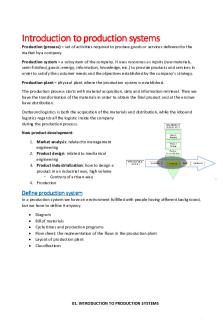Decoding the DNA of Toyota Production System PDF

| Title | Decoding the DNA of Toyota Production System |
|---|---|
| Author | Sean Tatro |
| Course | Operations Management |
| Institution | Ohio State University |
| Pages | 2 |
| File Size | 44 KB |
| File Type | |
| Total Downloads | 8 |
| Total Views | 146 |
Summary
Harvard Business Review - Decoding the DNA of Toyota Production System...
Description
Decoding the DNA of Toyota Production System (TPS): Many companies attempt to imitate TPS within their own orgs. Why? Because they fail to apply the four unwritten rules. 3 rules are of that of design, which show how Toyota set up all of it’s operations as experiments, and one rule for improvement, which describes how Toyota teaches the scientific method to workers at every level fit’s organization. Each improvement in Toyota’s processes follows the scientific method, anything less would amount to little more than trial and error Four Rules:
Rule 1 : How people work: o All work is highly specified in its content, sequence, timing, and outcome Employees follow a well-defined sequence of steps for a particular job. This specificity enables people to see and address deviations immediately – encouraging continual learning and improvement o Two Hypothesis The person doing the activity is capable of performing the task correctly Preforming the activity has the desired outcome Rule 2: How people connect: o Each worker knows who provides what to him, and when Workers needing parts submit cards specifying part number, quantity, and required destination. Suppliers must respond to materials requests within specified periods of time. Workers encountering a problem ask for help immediately. Designated assistants must respond at once and resolve the problem within the workers cycle time (e.g. the 55 seconds it takes to install a front seat) Failure to fulfill these specifications signals a search for potential causes such as ambiguous requests from colleagues or an overwhelmed assistance. Once the cause is identified it is resolved rather than kept hidden o This rule creates a supplier – customer relationship between each person and the individual who is responsible for providing that person with each specific good or service o When a worker puts in a request there is no question as to who will deliver the good or service, how the help will be triggered, and what services will be delivered. Rule 3: How the production line is constructed: o Every product and service follows along a simple, specified path Goods and services doesn’t follow to the next available person or machine but to a specific person or machine o When a request is put in for additional parts/goods/services the specific material handler responsible for providing the good/service makes requests to his own designated supplier at the off line store in the factory who, in turn, makes requests directly to his designated suppliers at the good/service factory shipping dock The production line links each person who contributes to the production and delivery of the product.
Provides a sense of purpose and satisfaction for each person responding to the request
Rule 4: How to improve: o Any improvement to process, worker/machine connections, or flow path must be made through the scientific method, under a teacher’s guidance, and at the lowers possible organizational level. Frontline workers make improvement to their own jobs, Supervisors provide direction and assistance as teachers. o Assembly workers were taught to improve their problem solving skills by redesigning their own work. o The workers were then assigned a leader who trained them to frame the problems better and to formulate and test hypotheses. o In other words he taught the individual workers to use the scientific method to design their teams work in accordance with the first three rules...
Similar Free PDFs

Decoding Question DNA Technology
- 2 Pages

Tps - toyota production système
- 12 Pages

Garment Production System
- 20 Pages

The flow of food production
- 3 Pages

Production System Laboratory Work
- 17 Pages

Copy of Decoding Breast Cancer
- 4 Pages

Analysis of toyota
- 16 Pages

Balance scorecard of Toyota
- 5 Pages
Popular Institutions
- Tinajero National High School - Annex
- Politeknik Caltex Riau
- Yokohama City University
- SGT University
- University of Al-Qadisiyah
- Divine Word College of Vigan
- Techniek College Rotterdam
- Universidade de Santiago
- Universiti Teknologi MARA Cawangan Johor Kampus Pasir Gudang
- Poltekkes Kemenkes Yogyakarta
- Baguio City National High School
- Colegio san marcos
- preparatoria uno
- Centro de Bachillerato Tecnológico Industrial y de Servicios No. 107
- Dalian Maritime University
- Quang Trung Secondary School
- Colegio Tecnológico en Informática
- Corporación Regional de Educación Superior
- Grupo CEDVA
- Dar Al Uloom University
- Centro de Estudios Preuniversitarios de la Universidad Nacional de Ingeniería
- 上智大学
- Aakash International School, Nuna Majara
- San Felipe Neri Catholic School
- Kang Chiao International School - New Taipei City
- Misamis Occidental National High School
- Institución Educativa Escuela Normal Juan Ladrilleros
- Kolehiyo ng Pantukan
- Batanes State College
- Instituto Continental
- Sekolah Menengah Kejuruan Kesehatan Kaltara (Tarakan)
- Colegio de La Inmaculada Concepcion - Cebu







